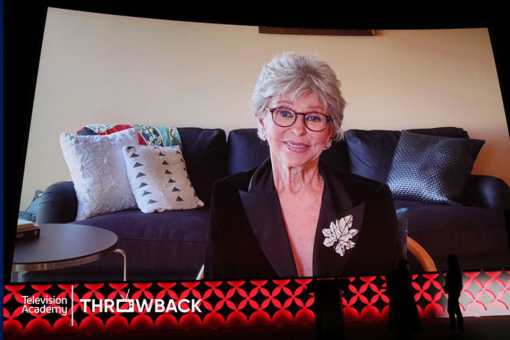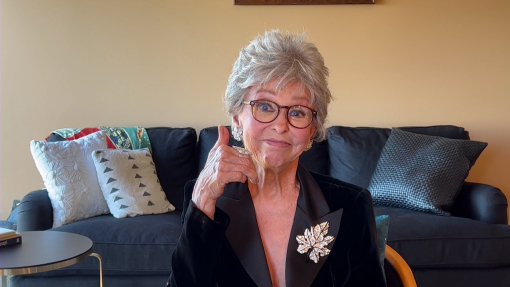Volumes have been written about how computers, the internet, the spread of cable television and ever smaller and more agile video equipment have democratized media and celebrity. And those tomes routinely cite reality TV as one of the most salient results of that sea change. But true innovation requires more than just a technological nudge and a lipstick cam; it requires visionaries. Enter producers Mary-Ellis Bunim and Jonathan Murray, unscripted television’s truly indispensable duo.
Over twenty years, Bunim/Murray Productions has notched a stunning roster of primetime series, some that are veritable household names (MTV’s The Real World, Road Rules, Project Runway, Keeping Up with the Kardashians, The Simple Life, Making the Band), others that came and went in the blink of a network programmer’s eye (The Rebel Billionaire, Love Cruise), but all of which have borne the shingle’s unmistakable stamp of closely examined humanity at its most vulnerable and abrasive, with all of its virtues and foibles. Heartbreaking. Jaw-dropping. Real.
“They essentially created the genre,” says Mark Itkin, the William Morris agent who introduced Murray and Bunim. He points out that, in addition to creating the most influential fly-on-the-wall reality franchise of all time in The Real World, Bunim/Murray went on to fashion non-scripted versions of classic television genres like the game show (Road Rules) and the sitcom (The Simple Life). “As far as I’m concerned, they deserve full credit for really establishing the non-scripted series business,” concludes Itkin, who is responsible for a storied collaboration that, in retrospect, seems both unlikely and inevitable.
A Mississippi native, Murray earned a journalism degree at the University of Missouri and went to work at a series of local news stations, graduating at the last of these (in Rochester, New York) to become a program director, where he found himself charged with acquiring syndicated programming. It was there that a station rep schooled him on the strategies of scheduling and spurred him to brainstorm some series ideas of his own.
Itkin attempted to broker a deal for Murray’s first creation, a daytime strip called Doctor, Doctor that was a cross between People’s Court and Marcus Welby, MD. (twenty years before Dr. Oz or The Doctors saw the light of syndicated day). The show didn’t make it to air, but Murray struck up a friendship with Itkin, who clearly saw some potential.
Murray’s next idea was a daytime anthology strip called Crime Diaries. Itkin was intrigued, but felt it was time to bring a more practiced development hand aboard. “As a packaging agent, you learn that if you’re going to take somebody who doesn’t have the experience, you’d better package them with somebody who does.”
Enter Mary-Ellis Bunim, a former executive producer of the daytime dramas Search for Tomorrow, As the World Turns, Santa Barbara and Loving, who was nearing the end of her tenure as head of the taped programming unit at New World Television. She and Murray were unable to find a buyer for Crime Diaries, but they clicked well enough to keep their collaboration going.
Three years later, Itkin called again, this time with a message from MTV: the music net was looking to create a scripted soap for its Gen X viewers. That project, titled St. Mark’s Place, was designed to chronicle the travails of a gaggle of college-aged kids starting life in New York’s East Village. The idea fell apart soon after MTV realized just how much it cost to mount a primetime drama, but when Bunim and Murray suggested the vastly simpler — and cheaper — alternative of telling the same story unscripted, MTV execs were all ears.
Thirty-eight thousand dollars and a long weekend later, a pilot emerged, which tested, as Murray recalls, “through the roof,” and MTV signed on. It would be another year, on May 21, 1992, until The Real World premiered. “Their typical primetime [rating] was a .3; that first night we took it to a .9,” Murray recalls. “Very quickly, they discovered that their audience was excited about this kind of programming.”
In crafting The Real World, Murray admits to the influence of the groundbreaking 1973 PBS documentary An American Family. “It was one of those very memorable experiences,” he says of the series, a stark observation of California’s drama-rich Loud family. “None of us had seen anything like it on television before.”
With Bunim/Murray established as a production entity, the pair went on to create an inimitable chapter in television history, the result of a unique personal and professional chemistry that would remain fruitful until Bunim’s untimely death in 2004 following a battle with breast cancer.
“We came at things from different directions,” Murray recalls. “My background was more about capturing human interaction as it happened, without blocking it, without telling people what to say, [while] Mary-Ellis had a wonderful gift for storytelling. A lot of times at our meetings, when we were putting a Real World episode together, she would say, ‘Well, if we were scripting this, how would it be? If Shakespeare were writing this story, how would he write it? And do we have those elements in what we shot?’” He adds, “She loved people, and was very curious about the world, so that played very well in to the idea of reality TV.”
As Itkin says of their “yin-yang” relationship: “They were very opposite people — personality-wise, training-wise, lifestyle-wise. Mary-Ellis grew up in the business, so she was very tough and demanding; Jon was much more laid-back, easygoing, kind of stoic. But they taught one another things, they learned from each other, and it just worked.”
After Bunim and Murray wowed MTV, a curious calm preceded the greater reality storm, as the pair struggled to expand the genre’s presence. With the exception of their 1999 ABC series, Making the Band, says Murray, “We pounded on doors and we just couldn’t sell reality stuff. It wasn’t until the year 2000, and the success of shows like Big Brother in Europe, that networks like CBS finally stepped into the picture.”
However, amidst that frustration, Murray recalls a moment of powerful validation: “We’d be over at Warner Bros. pitching, and very smart people would say to us, ‘Well, The Real World is scripted, isn’t it?’ People just couldn’t get that it could be real.”
At the same time, viewers had seemingly grown weary of network-manufactured scripted fare. “When reality took off, the scripted shows really gave us an opening because I do think they had gotten tired,” Murray theorizes. “I think reality sort of made those folks up their game. I think scripted television today is much better for having had reality breathing down its neck.”
It was the classic case of the idea whose time had come, agrees Tim Brooks, historian and co-author of The Complete Directory to Prime Time Network and Cable TV Shows. “This idea of real people in real situations — managed, but real situations — took television in a new direction.” And for every reality celebutante like Paris Hilton or Kim Kardashian, there are a dozen provocative but accessible Real World-ers like Puck (Season 3), Ruthie (Season 8) or Trishelle (Season 12). “Reality brought this sense that ‘There’s somebody I can really believe and relate to,”’ says Brooks. “I mean, it’s fun to watch Jerry Seinfeld and Tim Allen, but you know they’re not you. But now you’re watching people who could be you.”
Conversely, the shows turned some former nobodies into public-eye notables in their own right, like sixth-season cast member Sean Duffy, who went on to become a congressman from Wisconsin, and Mike Mizanin, who fulfilled a goal he boasted about on The Real World's tenth season of becoming a professional wrestler. He’s now “The Miz,” a former heavyweight champion of Vince McMahon’s grappling behemoth WWE. “They’re the reason that I am where I am today,” Mizanin says of Bunim and Murray. “They gave me the confidence I needed to be able to say that I could do whatever I wanted to do with my life.”
And while finding people with the right combination of friction was key to making the sparks that kept viewers rapt, Bunim/ Murray’s trademark casting also had the effect of expanding diversity, sometimes to poignant effect. “The first winner of Survivor was this Machiavellian gay character,” recalls Murray. “I can’t imagine CBS writing someone like that in one of their scripted shows. So I think reality TV really led the way in terms of participation of lesbians and gay people and other minority groups.”
Brooks observes, “While they had their spats, there’s a certain uplifting quality” to Bunim/Murray productions. “You’d have the girl from the Midwest show the smarties from the big city what it means to be a decent person. They weren’t framed as morality tales, but those subtle messages are built into their shows.”
Then there was the story of Pedro Zamora, who, during the third Real World season in San Francisco, confronted his HIV diagnosis: “He really brought the whole AIDS epidemic to the forefront for a lot of young people,” says Itkin. “I think they did a lot of important things as well as entertain people."
Murray isn’t reticent about proclaiming the influence that he and Bunim’s pioneering genre has had on both cable and network fare. “I think it opened up how they tell stories,” he explains. “The pacing of it, the way people come together. How many shows nowadays use the confessional that we did on The Real World back in 1993? Even the constructs of shows like Lost are almost like reality premises — ‘What would happen if we took a bunch of people and threw them on an island?”’
Though without his brilliant partner, Murray — who’s currently working on Real World 27 — can take pride in the indelible stamp on television history the pair has made. “At this point in my career, I feel like I can sit there and say, ‘Who do I want to work with?”’ he says. “‘Who do I want to spend time with?’ And that’s sort of fun.”
This tribute originally appeared in the Television Academy Hall of Fame program celebrating Mary-Ellis Bunim and Jonathan Murray’s induction in 2012.










